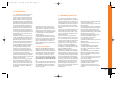
8
To change the crossover frequency
change the resistor network as follows:
1. Remove the screws from the bottom
panel as shown below.
2. Select which resistor module, high
pass or low pass, that you wish to
change.
3. A chip puller, which can be obtained
from any electronics store, is recom-
mended to remove the resistor chip. Pull
the resistor chip from the socket as
shown in the figure below.
4. Place the new module in the socket
making sure all pins are lined up with the
socket holes. Press the module firmly into
the socket.
5. Replace the bottom lid.
For further information on how to use the
speaker output and preamp output
crossovers for system building see the
“Typical Applications” and “Add-On and
Upgrade Steps” sections.
HIGH PASS
FILTER
FREQUENCY
SELECTION
MODULE
LOW PASS
FILTER
FREQUENCY
SELECTION
MODULE
C10
C13
JBL INC.
NORTHRIDGE, CA
JBL GTS600
PC00108800
REV A
CROSSOVER
6. Adjusting the Gain
Before operating the GTQ amplifiers,
recheck all wiring connections to make
sure they are correct and secure. Be sure
that a fuse (not included) is installed in the
+
12V line near the battery. Reconnect the
negative ground (–) terminal of the bat-
tery. Make sure that the mode switches,
crossover switches, Group 2 Input switch-
es, and crossover frequency modules are
properly set.
• The setting of the gain controls on the
GTQ amplifiers is important to ensure
proper performance, low noise levels, and
maximum reliability in the system.
Using a high signal level from the source
and a low gain setting on the amplifier
will help keep background noise levels in
the system low.
• To adjust a system using a single GTQ
amplifier, start with both of the amplifier
gain controls fully counterclockwise. Set
all bass/treble or equalizer controls to
their centered or bypassed positions.
While listening carefully to the system
output, adjust the volume control of the
radio/tape deck to the point where you
first begin to hear audible distortion.
Use caution: excessive distortion can
damage loudspeakers. Reduce the level
just to the point where the distortion goes
away. If this setting does not provide ade-
quate volume levels, gradually increase
(turn clockwise) the gain control for the
main (usually front) speaker groups on
the GTQ amplifier until the system plays
as loud as necessary or when the first
signs of distortion are heard.
–+
+–
R
L
–+– +
–+–+
System 1
Active 3-way using outboard tweeter amplifier
GTQ AMP
LOW-POWER
STEREO AMP
GR 1 GR 2
GR 1
Pre Out
GR 2
Input
GR 2
Pre Out
GR 1
Input
Input
LRRL
Midbass
Tweeters
Front
Subwoofers*
* A single (mono) subwoofer may be used by setting GR 2
mode to "L+R."
** The crossover frequencies listed are suggestions. Actual
crossover points should be determined from
loudspeaker requirements.
Speaker Preamp Group
Output Output 2
Mode CrossoverCrossover Input X-over Frequency
GR 1 Stereo Low High — 5k**
GR 2 Stereo Low High GR 2 80Hz**
7. Typical Applications
The following diagrams show the most
common basic system configurations of
the GTQ amps. One or more of these
building blocks may be combined to form
elaborate system designs.
The GTQ amps use the terminology
“Group 1” and “Group 2” to indicate the
two main signal paths within the amplifi-
er. Each “group” may consist of a mono
bridged signal or a stereo pair of L+R
signals depending on the system
configuration.
AIR FLOW
BEST-Vertical Mounting
AIR FLOW
GOOD-Horizontal Mounting
NEVER-Mount Upside Down
GTQ 360 new 7/17/98 10:44 AM Page 8














